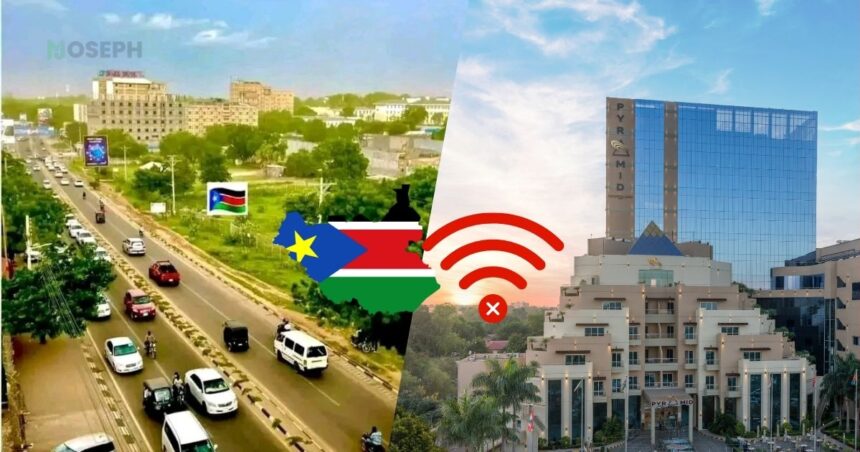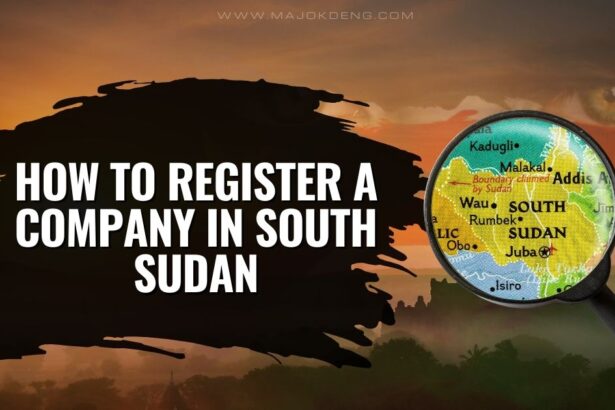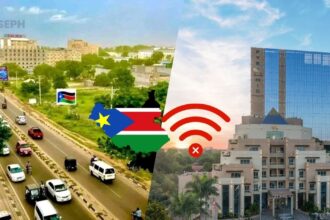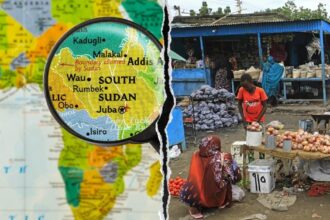Living in South Sudan often feels unpredictable. Sometimes we experience decent internet, but more often, we don’t. The South Sudanese government has been working hard to improve internet speeds, but with limited resources and big challenges, progress has been slow. It’s like the ratio of connectivity versus obstacles.
For example, in many South Sudanese neighborhoods, Wi-Fi internet speeds go between 5 Mbps and 6 Mbps, while on MTN cellular near the River Nile, it can reach about 5 Mbps to 7 Mbps based on tests I ran with 10 phones. This is really low compared to neighboring Kenya, where cellular speeds can go over 150 Mbps.
Despite these efforts, many factors still hold back good internet access. Here are ten reasons why South Sudan struggles with getting reliable and fast internet services.
1. Underdeveloped Infrastructure
South Sudan’s internet still depends heavily on satellite and microwave links, especially outside Juba. Fibre connections remain limited. Only a few backbone lines reach the capital from Uganda, and until 2024, there were no cross-border links from Kenya or Ethiopia. Even in Juba, fibre coverage is patchy. In the rest of the country, most places connect through VSAT or spotty 3G towers.
Speed tests back this up. The median download speed across South Sudan sits around 7 Mbps, matching what I recorded between Juba and the Nile. That’s far behind Kenya, where mobile speeds often go beyond 150 Mbps. In practice, it means video calls lag, downloads stall, and everyday services like school platforms or mobile banking struggle to stay online.
Geography makes things worse. During the rainy season, up to three-quarters of counties face serious flooding. Roads vanish into mud, towers go underwater, and trucks carrying internet equipment get stuck for weeks. In some cases, providers use barges or helicopters just to deliver parts or fuel to remote towers. These delays make small outages last far longer than they should.
Most of the country doesn’t have all-weather roads. Even in dry months, it can take days to move basic equipment from a port or warehouse to a rural site. Without electricity in many areas, providers also need to transport and maintain generators or solar systems alongside the usual tech gear. I’ve seen entire projects stall because no fuel could reach a tower during flood season.
These costs add up. Telecom companies often look at the economics and decide it isn’t worth it. Serving small, scattered villages is expensive, and the return is too low to justify the investment. So the areas most in need of connection are the ones left behind.
That may begin to change. In July 2023, the World Bank approved a $67 million grant to extend backbone fibre from Juba toward major border crossings. The plan includes regulatory upgrades, a universal service fund for rural internet, and three cross-border fibre routes. Napoleon Adok from the National Communication Authority said it could lower wholesale prices and let smaller companies extend coverage more easily. Work is expected to start by the end of 2025.
If this project stays on track, it could finally give South Sudan the foundation needed for modern, stable internet. For now, though, infrastructure gaps remain the biggest barrier to real connectivity.
2. Political Instability and Conflict
When conflict breaks out in South Sudan, internet services often disappear along with the sense of stability. In March and April 2025, fighting near Nasir displaced over 50,000 people and triggered a blackout across multiple zones. While there were no confirmed strikes on infrastructure, aid monitors reported that the “mobile network is reportedly down in the area” during bombardments. That blackout lasted for weeks and matched what I personally experienced: silence, no signal, no access to anything online.
This happens often, and the reasons are clear:
- Damage and Disruption: In conflict zones like Nasir, even when towers aren’t directly hit, network outages are common. Microwave links get interrupted, power sources are cut, or services are shut down for safety.
- Crew Safety and Access: Technicians regularly cancel repair missions because of unsafe roads or active fighting. Some crews abandon jobs mid-mission when violence flares up nearby. Routine tower checks get skipped for weeks.
- Investor Hesitation: A fibre line can cost millions. With no guarantee it won’t be destroyed during the next round of violence, most investors avoid the risk. High insurance costs and lack of legal protection add to the hesitation.
- Funding Reallocation: The government often shifts resources from technology upgrades to emergency responses. Broadband projects are paused or cancelled entirely when violence intensifies.
- Loss of Outside Expertise: Global telecom providers avoid regions under travel advisories. With few international staff on the ground, local crews are left to handle complex setups without support.
The result is visible across South Sudan. Fibre lines are built but never connected. Towers go up but are left idle. Many regions are served by incomplete or abandoned systems. Until conflict stops interfering with every part of internet development, from planning to repair, we won’t get the stable connectivity people here need.
3. Economic Constraints
For most people in South Sudan, the internet is a luxury. A single gigabyte of mobile data costs around $2.51 on average, and in some cases went as high as $7 per gigabyte in 2022. That might not sound extreme elsewhere, but for South Sudanese families living on less than two dollars a day, it’s completely out of reach. One study said people here need to spend more than 2,000% of their daily income just to buy 1 GB of data. I’ve seen families skip meals or hold off on other needs just to afford a week’s worth of browsing.
Government spending faces the same kind of pressure. With a GDP per capita of just $334 in 2024, and over 75% of people living below the global poverty line, it’s hard to justify big investments in internet infrastructure. Health, education, and security always come first. When budgets are already strained by flooding, inflation, or unpaid salaries, internet development usually gets pushed aside.
Running a telecom company here is expensive. Equipment has to be imported, power supplies need backup generators because the national grid is unreliable, and the cost of insurance is high. In late 2024, operators raised tariffs by over SSP 600 after the local currency lost more value. Michael Makuei, a government minister, explained that most parts are bought in US dollars, so as the pound weakens, everything gets more expensive.
Since 2022, the South Sudanese pound has lost over 60% of its value, and inflation reached over 30% by early 2023. This makes it even harder for providers to keep costs low or for consumers to keep up with prices. It also discourages new companies from entering the market.
At the same time, foreign investment remains scarce. Broadband penetration stands at only 9%. Investors are hesitant because of political instability, unclear regulations, and the small size of the paying customer base. Those who might invest often decide it’s too risky, or not worth the return.
There are some hopeful signs. Mobile money usage is slowly rising, and in some communities, people pool money to share connections or bundle costs. These grassroots efforts show that demand exists. But without wider economic improvements, many people will remain offline.
4. Regulatory and Policy Issues
South Sudan’s internet struggles are not only about money or equipment. The rules that shape the sector are often unclear or incomplete. The National Communication Authority (NCA) is the main regulatory body, guided by the National Communications Act passed in 2016. But in practice, responsibilities often overlap. The Ministry of ICT and Postal Services, and the Ministry of Information, Communication and Broadcasting also play roles, which creates confusion. This causes delays and frustration for both investors and local entrepreneurs trying to set up services.
A clear example of this confusion was the 2018 Vivacell dispute. The company was forced to shut down operations over licensing disagreements and unresolved tax issues. That case scared off other potential investors and showed how fragile the system can be when rules aren’t consistently applied or understood. I’ve heard of smaller operators who spent months waiting for permits, only to be bounced between agencies that couldn’t agree on who had the final say.
Even where regulations exist, enforcement can be patchy. Companies that try to follow the law often find their competitors cutting corners and facing no consequences. This unpredictability makes it difficult to build trust or plan long-term.
The costs of doing business are made worse by taxes and import duties. While there are no public breakdowns of telecom tax rates, several providers have blamed rising tariffs on unclear tax rules and the high cost of getting equipment into the country. These costs get passed on to consumers, widening the digital gap.
Policy also tends to favor urban centers. In 2021, rural internet penetration was estimated at just 15%, even though young people make up more than 70% of the population nationwide. Most regulations and pilot programs focus on Juba and a few state capitals. This leaves the vast rural majority without access or support.
There is some progress. The NCA’s Strategic Plan for 2023 to 2027 includes reforms aimed at universal access, clearer licensing, and support for public-private partnerships. A few early efforts, like the iPRIS platform for managing telecom records, show that change is possible.
Still, until rules are clearer and better enforced, telecom growth in South Sudan will remain limited to a few urban pockets while the rest of the country waits.
5. Geographical Challenges
South Sudan’s size alone makes internet expansion hard. The country is roughly the same size as France, yet its population is scattered across a vast and often difficult landscape. This means a single tower might only serve a small number of people, making it costly for providers to operate in rural areas.
The Sudd swamp adds another layer of complexity. It stretches from about 8,300 square kilometers during the dry season to over 80,000 square kilometers when rains are heavy. This terrain makes construction nearly impossible in some areas. I’ve seen towers designed with floating foundations just to survive the soft ground. These adjustments raise installation costs and make maintenance harder.
Flooding is another constant issue. From August 2024, more than 735,000 people were displaced by floods across 38 counties. Roads disappeared under water, and telecom lines were cut off for weeks. In some places, even diesel for tower generators couldn’t be delivered because trucks couldn’t reach them.
Many settlements are small and far apart. Connecting these areas takes much more investment per user than in towns or cities. Providers often choose to skip them, leaving whole regions disconnected.
Mountains in Eastern Equatoria cause their own problems. Signal from towers can’t travel over the ridges, so either additional towers are needed or coverage is lost entirely. I’ve visited villages less than five kilometers from a tower that had no signal at all because a hill blocked the line of sight.
Crossing the White Nile is another technical challenge. Fibre cables have to be specially reinforced and installed using boats or bridges. During high water, some projects are delayed for months. I’ve seen one installation stopped halfway through because the river became too dangerous to cross.
Power is yet another obstacle. Just 7% of rural households have access to electricity. Most towers run on diesel or hybrid solar systems. The African Development Bank and Finnfund are investing $20 million to solarize over 400 towers. MTN has also begun setting up 100 solar charging hubs in remote villages. These small changes are helping, but they still cover only a fraction of what’s needed.
South Sudan’s geography demands more than just ordinary telecom solutions. It requires flexibility, long-term investment, and a deep understanding of local conditions. Without that, entire regions will remain cut off from the rest of the world.
6. Low Digital Literacy
Even where the internet is available, most people in South Sudan can’t use it effectively. As of early 2024, only 12.1% of the population was online. That’s about 1.36 million users. Nearly 88% remain offline. A big part of that is due to low digital skills and limited general literacy.
Adult literacy stands at around 27% nationwide. For women, it’s even lower. Less than 16% are able to read and write. Without basic reading skills, learning how to use digital tools becomes a bigger challenge. Many South Sudanese, especially in rural areas, have never used a computer or smartphone beyond basic calling or messaging.
Digital literacy itself is estimated at around 10%. Most students struggle with even simple computer tasks. South Sudan ranks lowest on the global AI readiness index, scoring just 0.55 out of 100. This shows how far we are from building the kind of tech-skilled workforce needed for long-term development.
There are efforts to close the gap. In 2024, UNESCO opened a digital literacy center at Juba Day Secondary School. The program trained 114 students. The Open Knowledge Foundation also launched small digital learning projects at Eloi Secondary School. WPDI, with support from Zain, trained about 1,000 people in camps and remote areas in early 2025. These programs help, but they are still small and mostly based in a few locations.
Low digital literacy has wider consequences. It limits how people use online services. It reduces demand for internet subscriptions. It slows adoption of tech in businesses and government offices. It also discourages investors who often see the lack of skills as a major obstacle to building digital services or platforms.
Without basic digital education across the country, internet access alone will never be enough. More schools, training centers, and community programs are needed to help people learn how to use technology, not just own it.
7. High Costs of Deployment
Building internet infrastructure in South Sudan is expensive at every stage. Whether it’s equipment, labor, fuel, or transport, everything costs more here than in most other countries.
Start with the technology itself. A basic Starlink kit costs around $499. Once shipping, import duties, and currency conversion are added, the local price climbs to between SSP 1.1 million and 1.26 million. That’s more than most families make in a year. If one satellite unit is this expensive, it’s easy to see why full networks are slow to expand.
Terrain makes things even harder. Much of the country is covered by flood zones, swamps, or rocky ground. In the Sudd region, engineers sometimes have to build floating tower bases or create custom foundations. In mountainous areas, signal requires more towers to avoid line-of-sight problems. Every physical challenge adds new costs in planning, construction, and long-term upkeep.
Once a tower is up, keeping it running isn’t cheap. Flooding, heat, and conflict damage equipment. Diesel generators are required in most areas due to the lack of reliable electricity. Spare parts must be imported, and reaching remote areas means paying for fuel, staff, and security. Some providers spend more on maintenance than on the original installation.
The size and population spread of South Sudan add another barrier. With just 12 to 15 percent of people online, the user base is too small to spread costs efficiently. A single tower might only serve a few hundred people, making the cost per user extremely high. Even in areas with service, usage remains low because of poverty, digital illiteracy, or both. That weak demand limits revenue and discourages private investment.
Everything depends on imports. Most equipment, cables, routers, and tools come from abroad. With the South Sudanese pound losing value year after year, and new tariffs added to cover government shortfalls, import prices keep rising. Poor roads, seasonal floods, and long customs delays make delivery unpredictable and expensive. I’ve seen projects stalled for months just waiting for one missing part to arrive.
Until these cost pressures are eased through public investment, shared infrastructure, or better local supply chains, the price of getting online in South Sudan will remain painfully high.
8. Dependence on External Aid
South Sudan relies heavily on donor funding to support its infrastructure and development projects, including telecoms. Each year, the country receives between $1.64 billion and $1.86 billion in aid, mostly from governments like the US, EU, and UK. While this support is vital, it also creates challenges that affect long-term internet development.
One major issue is uncertainty. Donor funding often shifts based on international politics or global emergencies. Priorities change, and programs are delayed, downsized, or redirected. Most of this aid also comes with conditions. Under what experts call the “push model,” donors define the project goals and timelines. That can result in projects that look good on paper but don’t match the local telecom needs.
Bureaucracy makes it worse. Infrastructure projects supported by donors must often go through agencies like the Inter-ministerial Appraisal Committee (IMAC). These layers of review slow everything down. I’ve seen projects delayed for months, not because of technical issues, but because they were waiting for the right sign-off. Sometimes different donors fund overlapping projects without proper coordination, leading to wasted resources.
The heavy reliance on aid also discourages local investment. Nearly half of all international aid is for humanitarian use, not long-term development. As outside donors dominate the funding space, private investors become hesitant. They worry about competing with subsidized programs or being left out of closed systems. This is often referred to as the “aid dependence trap,” where countries lose the ability to build local capacity and systems that can sustain themselves.
Another concern is accountability. Much of the aid money bypasses South Sudan’s local institutions. That limits oversight and increases the risk of mismanagement or corruption. Even well-intentioned programs can fail if they don’t build in proper checks and local input.
Foreign support will remain important for South Sudan’s internet goals, but without stronger domestic involvement and planning, aid alone won’t build a connected future.
9. Limited Market Size
South Sudan’s relatively small and dispersed population limits the market size for internet services, impacting the development of high-quality internet access. With a total population of about 11.1 million spread across 644,329 square kilometers, the density is roughly 13 people per square kilometer. This makes it expensive and logistically difficult to provide reliable coverage in rural or remote areas.
Even where service exists, usage remains low. As of early 2024, only 12.1% of the population, or about 1.36 million people, were active internet users. Mobile broadband coverage reaches just 37%, and fixed broadband is only at 9%. These numbers show how limited the user base is, keeping the potential market small and financially risky.
Affordability is another issue. Many South Sudanese live on very low incomes and cannot sustain regular internet payments. Providers face low returns and high per-user costs, especially when infrastructure has to be built in remote, low-density regions.
The business environment adds to the problem. There are few large companies or institutions that require high-capacity internet connections. Most usage is limited to individuals and small businesses, which means providers cannot rely on bulk or enterprise clients to support their investments.
Low digital literacy and cultural barriers also reduce internet demand. Many people do not yet see the internet as useful or necessary in everyday life. This slows adoption and reduces the incentive for companies to expand services.
Together, these factors keep South Sudan’s internet market small. Unless major shifts occur in education, income levels, or infrastructure support, most providers will continue to see the country as a difficult place to expand.
10. Security Risks and Legal Gaps
Internet growth in South Sudan faces real threats from both physical insecurity and weak legal protections. Telecom infrastructure is often damaged or disrupted during violence. While there’s no confirmed count of towers destroyed, providers frequently report service interruptions during clashes. Repairs become costly and slow, especially when roads are blocked or equipment is targeted.
Safety risks for workers are also high. Installing or maintaining telecom lines in conflict zones requires extra security, which raises the cost of every project. Though formal numbers aren’t widely available, telecom teams often mention needing escorts or delaying visits due to safety concerns.
On the legal side, South Sudan passed the Cybercrimes and Computer Misuse Order in 2021. This was a step toward regulating online activity, but the country still lacks a dedicated data protection law. It also hasn’t ratified the Malabo Convention, which sets digital rights and cybersecurity standards across Africa. Without these frameworks, both users and businesses face the risk of data breaches and misuse.
This legal gap affects trust. Companies hesitate to store or process data locally. Users worry about privacy, especially since some parts of the 2021 Order have been criticized as vague or overly broad. Advocacy groups like CIPESA have warned that these laws could be used to monitor citizens unfairly or suppress free expression.
Security risks also raise the cost of doing business. Projects in unstable regions attract higher insurance premiums. While no official insurance rates were found for South Sudan, global patterns suggest major increases in high-risk zones. Combined with travel advisories and supply chain threats, this keeps many foreign investors away.
The result is a cycle of low confidence. Infrastructure breaks down or stalls. Laws are unclear or inconsistently applied. People hesitate to trust or rely on digital platforms. Until these risks are addressed through stronger protections and safer working conditions, internet growth will remain fragile.
Conclusion
Getting better internet in South Sudan isn’t just about laying cables or buying equipment. It means fixing the real reasons we’ve talked about: conflict, legal gaps, low skills, limited funding, and poor infrastructure. These 10 reasons explain why South Sudan still lacks high-quality internet. Solving them needs local solutions, better planning, and honest coordination. Without that, we’ll keep falling behind no matter how much money is spent.








